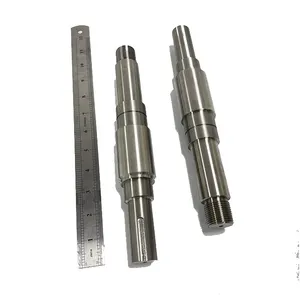
Custom Precision Water Pump Bearing Shaft Cnc Lathe Turning Rotary Drive Shafts Stainless Steel Pump Shafts


2.2KW-7.5KW Low-Speed Off-Highway Vehicle Electric Transaxle Drive Rear Axle Propeller Shaft Solutions Part of Propeller Shafts





















Electric drive shafts are integral components in the realm of automotive engineering, designed to transmit power from an electric motor to drive shaft within a vehicle. These shafts are pivotal in ensuring that the torque generated by the motor is effectively conveyed to the wheels, allowing for smooth propulsion. The sophistication of electric drive shafts lies in their ability to maintain power transmission even when subjected to varying angles and stress levels between connected elements.
The versatility of electric drive shafts is evident in their various types, each tailored to specific vehicle architectures. From the robust oceanvolt shaft drive systems used in marine applications to the minn kota e drive electric outboard 1371010, which is a staple in electric boating solutions, the range is extensive. In the automotive sector, the drive shaft electric motor configuration is critical for electric and hybrid vehicles, ensuring efficient power delivery from the motor to the drivetrain.
Electric drive shafts are not just about power transmission; they are also about precision and durability. The materials used in their construction, such as carbon fiber, are selected for their strength-to-weight ratio, which is essential for performance vehicles where every kilogram matters. The use of carbon fiber also exemplifies the adaptability of these components, as the material can be engineered to meet specific requirements, enhancing the electric drive shaft in terms of stiffness and strength without the weight penalty of traditional materials.
The transition to electric drive systems has brought to light the numerous advantages of using electric drive shafts. These include a reduction in the number of moving parts, which inherently decreases maintenance needs and increases reliability. Furthermore, the integration of an inline drive shaft electric motor can lead to a more compact design, freeing up space for other vehicle components or additional battery capacity, which is a significant advantage in electric vehicle design.
Customization is a key aspect when selecting an electric drive shaft, with assemblies often comprising a journal, shaft, bearings, and U-joints. It is crucial to ensure that these components are compatible with the vehicle's specifications, including size, type, and the load they will bear. This attention to detail ensures that the electric drive shaft operates at peak efficiency, contributing to the overall performance and longevity of the vehicle's powertrain.
In conclusion, electric drive shafts are a testament to the evolution of power transmission technologies in the automotive industry. Their development reflects the shift towards more efficient, reliable, and high-performance components that are capable of meeting the demands of modern electric and hybrid vehicles. As the industry continues to innovate, the role of electric drive shafts will undoubtedly become even more pivotal in the engineering of next-generation vehicles.